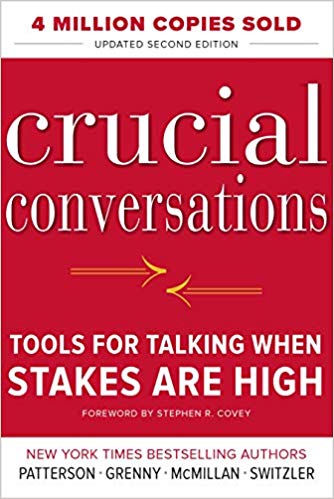

This article is an excerpt from the Shortform summary of "Crucial Conversations" by Kerry Patterson. Shortform has the world's best summaries of books you should be reading.
Like this article? Sign up for a free trial here .
What is “make it safe” in Crucial Conversations? What does “make it safe” mean?
Make it safe in Crucial Conversations refers to the process of ensuring that the conditions of a conversation are safe, and both parties can express themselves. But how do you make it safe? Crucial Conversations has the answer.
Make It Safe: Crucial Conversations and a Healthy Dialogue
The first prerequisite for healthy dialogue is safety. You can’t have constructive dialogue when people don’t feel safe, because they start acting in unproductive ways and stop contributing their information to the shared pool.
To maintain safety in a conversation, you must consider two elements: what is being discussed and what’s happening in response — both the content and the conditions of the conversation. In crucial conversations, make it safe should be a priority.
Most people focus on the content, but the conditions are equally important.
- If conditions are safe, you can say almost anything and people will listen.
- If you’re not afraid you’re being attacked, you can hear almost anything and not become defensive. People rarely become defensive because of what you’re saying (content), only when they don’t feel safe.
- You’re receptive to potentially threatening feedback when you believe the other person has your best interests in mind and you respect their opinion. You trust their motives and don’t feel a need to defend yourself. Conversely, if you don’t feel safe, you can’t take any feedback. You suspect even well-intentioned comments (“What do you mean by saying I look good?”).
Nonetheless, it’s easy to get caught up in the content and care so much about the subject that you don’t notice what’s happening to the dialogue, which can quickly become unproductive. For instance, you or someone else may be speaking too forcefully; others may feel threatened and shut down, or become increasingly forceful themselves. In crucial conversations, “make it safe” means it’s clear that this doesn’t work.
You need to monitor both content (the topic) and conditions (what people are doing in response) simultaneously. Look at what and why: People are getting upset. Why is this happening?
The rest of this chapter focuses on how to monitor and maintain safe conditions for conversation, while Chapter 5 focuses on making the content safe (discussing difficult topics safely).
Make It Safe: Steps
The steps to make it safe during crucial conversations are:
- Spot the turning point: Notice when the conversation becomes crucial.
- Watch signs of a safety problem.
- See if others are moving toward silence or violence.
- Beware of reverting to your style under stress.
1. Spot the Turning Point
Stay alert for the moment a conversation turns from harmless to crucial so you can avoid getting sidetracked by emotions and can intervene if others go off track. Reprogram your mind to pay attention to signs — physical, emotional, and behavioral — that suggest you’re in a crucial conversation.
- Physical: Your body sends signals — for instance, your face may flush or your shoulders may tense up. These are your cues to step back and remember your original purpose.
- Emotional: You or others start to feel afraid, angry, or hurt. You begin to react to or suppress these feelings. These are cues to slow down.
- Behavioral: People raise their voices or become quiet.
2. Watch for Signs of a Safety Problem
Once you see that a conversation is starting to turn crucial, pay attention to safety: Watch for signs people are becoming fearful. When this happens they take a fight or flight response, and you’re no longer in a “make it safe” crucial conversations environment.
- Force their views on others (fight), for instance by talking over other people. They do this when they fear that people aren’t buying into what they’re saying.
- Withhold their opinions for fear of being attacked (flight).
When people begin to feel unsafe, they may push, insult, be sarcastic, or make fun of you. While you should be thinking about how to make them feel safer, it’s difficult when you feel under attack — you may get emotional and respond in kind (or withdraw). At this point, you’re not dual-processing but becoming part of the problem as you get pulled into the fight.
When your emotions start ratcheting up, your key brain functions start shutting down. Your peripheral vision actually narrows — when you feel genuinely threatened you can’t see much beyond what’s right in front of you.
By pulling yourself out of the content of an argument and looking at conditions objectively, you reengage your brain and your vision returns. When you give your brain a new problem, it functions better.
Reinterpret others’ aggression as a sign they don’t feel safe — be curious, rather than angry or fearful — and take steps to change the conditions of the conversation in order to reestablish the “make it safe” crucial conversations environment.
3. Look for Silence and Violence
In order to make it safe in crucial conversations, there’s no room for unsafe behavior. When people resort to silence or violence — either withholding meaning or trying to force it on the shared pool — there are some common behaviors and tactics to look for.
Silence
Silence is any act to purposely withhold information from the pool of meaning. People usually go silent to avoid problems.
Behaviors include playing verbal games or avoiding a person entirely. But the most common forms of silence are masking, avoiding, and withdrawing.
- Masking: Understating or selectively showing your true opinions using sarcasm, sugarcoating, and couching. For example: “Oh, sure. That’ll work like a charm.”
- Avoiding: Steering completely away from sensitive subjects; you talk without addressing the real issues. For example, when someone asks how you like their outfit, you respond: “Well, you know red’s my favorite color.”
- Withdrawing: Pulling out of a conversation; withdrawing or even leaving the room. For example, “I just can’t talk about this right now.”
Violence
Violence is a verbal strategy to convince or compel others to accept your point of view. Trying to force meaning into the pool violates safety. Behaviors include name-calling, filibustering, and making threats, but the most common are controlling, labeling, and attacking.
- Controlling: Coercing others to your way of thinking by either forcing your views on others, or dominating the conversation. Methods include cutting others off, overstating your facts (hyperbole), speaking in absolutes, changing subjects, or using directive questions to control the conversation. For example: “Everyone knows they have the worst customer service in the universe.”
- Labeling: Attaching a label in order to stereotype or dismiss someone or their idea. For example, “You sound like a Neanderthal.”
- Attacking: You move from winning the argument to making the other person suffer. Tactics include belittling and threatening. For example: “You’re a real jerk! I’m sorry but someone has to tell the truth here.”
Learning to make it safe in crucial conversations is one of the most important parts of learning to connect and communicate. Without making it safe, crucial conversations cannot happen, and you will continue to communicate unproductively.

———End of Preview———
Like what you just read? Read the rest of the world's best summary of Kerry Patterson's "Crucial Conversations" at Shortform .
Here's what you'll find in our full Crucial Conversations summary :
- How to approach an argument without getting mad
- The mistakes most people make when trying to listen to someone else
- How to come up with win-win solutions that make everyone happy






